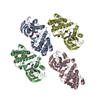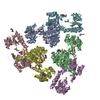[English] 日本語
 Yorodumi
Yorodumi- PDB-7sz5: Cryo-EM structure of the extracellular module of the full-length ... -
+ Open data
Open data
- Basic information
Basic information
| Entry | Database: PDB / ID: 7sz5 | |||||||||
|---|---|---|---|---|---|---|---|---|---|---|
| Title | Cryo-EM structure of the extracellular module of the full-length EGFR bound to TGF-alpha "tips-separated" conformation | |||||||||
 Components Components |
| |||||||||
 Keywords Keywords | SIGNALING PROTEIN / receptor tyrosine kinases / epidermal growth factor receptor | |||||||||
| Function / homology |  Function and homology information Function and homology informationhepatocyte proliferation / Cargo concentration in the ER / response to hydroxyisoflavone / multivesicular body, internal vesicle lumen / positive regulation of prolactin secretion / negative regulation of cardiocyte differentiation / positive regulation of protein kinase C activity / diterpenoid metabolic process / Shc-EGFR complex / COPII-mediated vesicle transport ...hepatocyte proliferation / Cargo concentration in the ER / response to hydroxyisoflavone / multivesicular body, internal vesicle lumen / positive regulation of prolactin secretion / negative regulation of cardiocyte differentiation / positive regulation of protein kinase C activity / diterpenoid metabolic process / Shc-EGFR complex / COPII-mediated vesicle transport / ovulation cycle / Inhibition of Signaling by Overexpressed EGFR / epidermal growth factor receptor activity / EGFR interacts with phospholipase C-gamma / positive regulation of mucus secretion / response to UV-A / epidermal growth factor binding / PLCG1 events in ERBB2 signaling / tongue development / midgut development / ERBB2-EGFR signaling pathway / hydrogen peroxide metabolic process / PTK6 promotes HIF1A stabilization / digestive tract morphogenesis / epidermal growth factor receptor binding / morphogenesis of an epithelial fold / ERBB2 Activates PTK6 Signaling / intracellular vesicle / Signaling by EGFR / response to cobalamin / transmembrane receptor protein tyrosine kinase activator activity / protein tyrosine kinase activator activity / negative regulation of epidermal growth factor receptor signaling pathway / Signaling by ERBB4 / eyelid development in camera-type eye / regulation of phosphatidylinositol 3-kinase/protein kinase B signal transduction / protein insertion into membrane / cerebral cortex cell migration / ERBB2 Regulates Cell Motility / Respiratory syncytial virus (RSV) attachment and entry / regulation of JNK cascade / : / positive regulation of cell division / PI3K events in ERBB2 signaling / positive regulation of cyclin-dependent protein serine/threonine kinase activity / negative regulation of mitotic cell cycle / hair follicle development / Estrogen-dependent nuclear events downstream of ESR-membrane signaling / MAP kinase kinase kinase activity / embryonic placenta development / mammary gland alveolus development / positive regulation of bone resorption / positive regulation of G1/S transition of mitotic cell cycle / GAB1 signalosome / salivary gland morphogenesis / peptidyl-tyrosine autophosphorylation / regulation of peptidyl-tyrosine phosphorylation / positive regulation of phosphorylation / positive regulation of glial cell proliferation / positive regulation of vasoconstriction / Signaling by ERBB2 / cellular response to epidermal growth factor stimulus / GRB2 events in EGFR signaling / SHC1 events in EGFR signaling / cellular response to cadmium ion / EGFR Transactivation by Gastrin / positive regulation of DNA repair / GRB2 events in ERBB2 signaling / TFAP2 (AP-2) family regulates transcription of growth factors and their receptors / transmembrane receptor protein tyrosine kinase activity / endoplasmic reticulum-Golgi intermediate compartment membrane / SHC1 events in ERBB2 signaling / positive regulation of mitotic nuclear division / positive regulation of synaptic transmission, glutamatergic / cellular response to dexamethasone stimulus / ossification / neurogenesis / regulation of ERK1 and ERK2 cascade / basal plasma membrane / neuron projection morphogenesis / positive regulation of superoxide anion generation / positive regulation of DNA replication / epithelial cell proliferation / Signal transduction by L1 / cellular response to estradiol stimulus / positive regulation of epithelial cell proliferation / NOTCH3 Activation and Transmission of Signal to the Nucleus / astrocyte activation / liver regeneration / positive regulation of protein localization to plasma membrane / EGFR downregulation / cellular response to amino acid stimulus / positive regulation of smooth muscle cell proliferation / Signaling by ERBB2 TMD/JMD mutants / growth factor activity / positive regulation of MAP kinase activity / lung development / clathrin-coated endocytic vesicle membrane / Constitutive Signaling by EGFRvIII / Signaling by ERBB2 ECD mutants Similarity search - Function | |||||||||
| Biological species |  Homo sapiens (human) Homo sapiens (human) | |||||||||
| Method | ELECTRON MICROSCOPY / single particle reconstruction / cryo EM / Resolution: 3.6 Å | |||||||||
 Authors Authors | Huang, Y. / Ognjenovic, J. / Karandur, D. / Miller, K. / Merk, A. / Subramaniam, S. / Kuriyan, J. | |||||||||
| Funding support |  United States, 2items United States, 2items
| |||||||||
 Citation Citation |  Journal: Elife / Year: 2021 Journal: Elife / Year: 2021Title: A molecular mechanism for the generation of ligand-dependent differential outputs by the epidermal growth factor receptor. Authors: Yongjian Huang / Jana Ognjenovic / Deepti Karandur / Kate Miller / Alan Merk / Sriram Subramaniam / John Kuriyan /   Abstract: The epidermal growth factor receptor (EGFR) is a receptor tyrosine kinase that couples the binding of extracellular ligands, such as EGF and transforming growth factor-α (TGF-α), to the initiation ...The epidermal growth factor receptor (EGFR) is a receptor tyrosine kinase that couples the binding of extracellular ligands, such as EGF and transforming growth factor-α (TGF-α), to the initiation of intracellular signaling pathways. EGFR binds to EGF and TGF-α with similar affinity, but generates different signals from these ligands. To address the mechanistic basis of this phenomenon, we have carried out cryo-EM analyses of human EGFR bound to EGF and TGF-α. We show that the extracellular module adopts an ensemble of dimeric conformations when bound to either EGF or TGF-α. The two extreme states of this ensemble represent distinct ligand-bound quaternary structures in which the membrane-proximal tips of the extracellular module are either juxtaposed or separated. EGF and TGF-α differ in their ability to maintain the conformation with the membrane-proximal tips of the extracellular module separated, and this conformation is stabilized preferentially by an oncogenic EGFR mutation. Close proximity of the transmembrane helices at the junction with the extracellular module has been associated previously with increased EGFR activity. Our results show how EGFR can couple the binding of different ligands to differential modulation of this proximity, thereby suggesting a molecular mechanism for the generation of ligand-sensitive differential outputs in this receptor family. | |||||||||
| History |
|
- Structure visualization
Structure visualization
| Movie |
 Movie viewer Movie viewer |
|---|---|
| Structure viewer | Molecule:  Molmil Molmil Jmol/JSmol Jmol/JSmol |
- Downloads & links
Downloads & links
- Download
Download
| PDBx/mmCIF format |  7sz5.cif.gz 7sz5.cif.gz | 245.6 KB | Display |  PDBx/mmCIF format PDBx/mmCIF format |
|---|---|---|---|---|
| PDB format |  pdb7sz5.ent.gz pdb7sz5.ent.gz | 189.3 KB | Display |  PDB format PDB format |
| PDBx/mmJSON format |  7sz5.json.gz 7sz5.json.gz | Tree view |  PDBx/mmJSON format PDBx/mmJSON format | |
| Others |  Other downloads Other downloads |
-Validation report
| Summary document |  7sz5_validation.pdf.gz 7sz5_validation.pdf.gz | 755.5 KB | Display |  wwPDB validaton report wwPDB validaton report |
|---|---|---|---|---|
| Full document |  7sz5_full_validation.pdf.gz 7sz5_full_validation.pdf.gz | 783.5 KB | Display | |
| Data in XML |  7sz5_validation.xml.gz 7sz5_validation.xml.gz | 40.2 KB | Display | |
| Data in CIF |  7sz5_validation.cif.gz 7sz5_validation.cif.gz | 61.4 KB | Display | |
| Arichive directory |  https://data.pdbj.org/pub/pdb/validation_reports/sz/7sz5 https://data.pdbj.org/pub/pdb/validation_reports/sz/7sz5 ftp://data.pdbj.org/pub/pdb/validation_reports/sz/7sz5 ftp://data.pdbj.org/pub/pdb/validation_reports/sz/7sz5 | HTTPS FTP |
-Related structure data
| Related structure data |  25561MC  7sydC  7syeC  7sz0C  7sz1C  7sz7C M: map data used to model this data C: citing same article ( |
|---|---|
| Similar structure data |
 Movie
Movie Controller
Controller Assembly
Assembly


 UCSF Chimera
UCSF Chimera











 PDBj
PDBj

